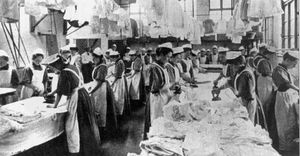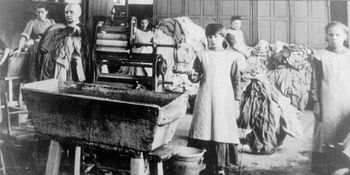|
The Magdalene Sisters: Women’s Oppression and the Irish Clericalist State
For
the Separation of Church and State!

Magdalene asylums were institutions
for so-called "fallen women". Although popularly associated with Ireland, there is nothing distinctly Irish or Roman Catholic
about them, indeed a number of the asylums, including the first in Ireland, were founded and run by members
of Protestant denominations. Asylums for "fallen women" operated throughout Europe, Britain, Ireland, Canada and the United
States for much of the nineteenth and well into the twentieth century. The first asylum in Ireland opened on Leeson Street
in Dublin in 1767, founded by Lady Arabella Denny.
Initially the mission of the asylums was often
to rehabilitate women back into society, but by the early twentieth century the homes had become increasingly punitive and
carceral (at least in Ireland and Scotland). In most asylums, the inmates were required to undertake hard physical labour,
including laundry and needle work. They also endured a daily regime that included long periods of prayer and enforced silence.
In Ireland, such asylums were known as Magdalene laundries. It
has been estimated that 30,000 women passed through Ireland's laundries. The last Magdalene asylum in the Republic of Ireland closed on September 25, 1996.
Magdalene
asylums grew out of the Protestant rescue movement in the UK and Ireland during the 19th century, which had as its formal
goal the rehabilitation of women who had worked as prostitutes. In Ireland, the institutions were nicknamed for St. Mary Magdalene,
who, according to Roman Catholic tradition, repented her sins and became one of Jesus' closest followers.
The
Magdalene movement in Ireland was quickly appropriated by the Catholic Church, and the homes, which were initially intended
to be short-term refuges, increasingly turned into long-term institutions. Penitents were required to work, primarily in laundries
since the facilities were self-supporting and not funded by the Catholic Church.
As
the Magdalene movement became increasingly distant from the original idea of the Rescue Movement (the goal of which was to
find alternative work for prostitutes who could not find regular employment because of their background) the asylums took
on an increasingly prison-like character. Supervising nuns were instructed to enact strong measures that would discourage
women from leaving and instead encourage them into penance. The Congregation of the Sisters of Misericordiae, for example,
is described by the Catholic Encyclopedia thus:
In receiving patients, no discrimination is made in regard to religion,
color, or nationality. After their convalescence, those who desire to remain in the home are placed under a special sister
and are known as "Daughters of St. Margaret". They follow a certain rule of life but contract no religious obligations. Should
they desire to remain in a convent operated by the Good Shepherd Sisters, after a period of probation, they are allowed to
become Magdalens and eventually take the three vows of the Sisters Magdalen, which was formed by Saint Mary of St Euphrasia
to meet the needs of the penitent desiring to enter a cloister within a cloister. Former penitents are barred from becoming
Sisters in the Good Shepherd Community, but can apply to novitiates in other orders, such as the Ursulines.
Bethany
Mother and Child Home was a Magdalene laundry run by members of the Church of Ireland. It was located at Blackhall Place in
Dublin from 1921 to 1934 and in Rathgar, until it closed in 1972, and has been the centre of allegations of abuse and neglect.
Recently the unmarked graves of infants who died at the Bethany Home were discovered.

Conditions
Asylum records show that in the early history of the Magdalene movement, many women entered and left the institutions
of their own accord, sometimes repeatedly. Lu Ann De Cunzo wrote in her book, Reform, Respite, Ritual: An Archaeology of Institutions;
The Magdalene Society of Philadelphia, 1800-1850, that the women in Philadelphia's asylum "sought a refuge and a respite from
disease, the prison or almshouse, unhappy family situations, abusive men and dire economic circumstances." Though some may
have taken refuge in the institutions, the asylums contained physical, psychological, sexual and emotional abuse. Many women
felt they needed the support of the institutions to survive, since the sisters strove to make them feel the reasons for their
refuge were their own fault.
According to Finnegan, because many had a background as prostitutes, inmates (who were called "children") were regarded
as "in need of penitence" and were required until the 1970s to address all staff regardless of age, as "mother". To enforce
order and maintain a monastic atmosphere, the inmates were required to observe strict silence for much of the day, while corporal
punishment was common, and passive-aggression was simply ignored:
As the phenomenon became more widespread, it extended beyond prostitution, to unmarried mothers, developmentally challenged
women and abused girls. Even young girls who were considered too promiscuous and flirtatious, or too beautiful, were sent
to an asylum. This paralleled the practice in state-run asylums in Britain and Ireland in the same period, where many people
with alleged "social dysfunction" were committed to asylums. The women were typically admitted to these institutions at the
request of family members (mostly men), priests and doctors. Without a family member on the outside who would vouch for them,
some penitents would stay in the asylums for the rest of their lives, many of them taking religious vows.
Given Ireland's historically conservative sexual values, Magdalene asylums were a generally accepted social institution
until well into the second half of the 20th century. They disappeared with the changes in sexual mores – or, as Finnegan
suggests, as they ceased to be profitable: "Possibly the advent of the washing machine has been as instrumental in closing
these laundries as have changing attitudes."
The
sending of wayward women to Magdalene Asylums was an example of what many feminists regard as the phenomenon in which even
alleged sexual misconduct by women is punished more harshly than sexual misconduct by men.
This section
does not cite any references or sources.
Please help improve this article by adding citations to reliable sources. Unsourced material may be challenged and
removed. (September 2009)
The existence of the Irish asylums was of little thought of until, in 1993, an order of nuns in Dublin sold part of
their convent to a real estate developer. The remains of 155 inmates, which had been buried in unmarked graves on the property,
were exhumed and, except for one body, cremated and reburied in a mass grave in Glasnevin Cemetery. This triggered a public
scandal (cremation is normally regarded as a dark throwback to paganism by Catholics) and became local and national news.
In 1999 Mary Norris, Josephine McCarthy and Mary-Jo McDonagh, all asylum inmates, gave accounts of their treatment. The 1997
Channel 4 documentary Sex in a Cold Climate interviewed former inmates of Magdalene Asylums who testified to continued sexual,
psychological and physical abuse while being isolated from the outside world for an indefinite amount of time. Allegations
about the conditions of the convents and the treatment of the inmates of the Irish asylums were made in the film The Magdalene
Sisters (2002), written and directed by Peter Mullan—a film which has been both acclaimed and criticized.
Inquiry into child abuse
In May, 2009, the Commission to Inquire into Child Abuse released a 2000 page report recording claims from hundreds
of Irish residents that they were physically, sexually or emotionally abused as children between 1930s and the 1990s in a
network of state administered and church-run residential schools meant to care for the poor, the vulnerable and the unwanted.
The alleged abuse was by nuns, priests and non-clerical staff and helpers. The allegations of abuse covers many Catholic and
State run Irish Industrial schools, including the Magdalene asylums. The Commission stated:
There were two types of inquiry, one drawing on contested
evidence (Investigation Committee) and the other on uncontested evidence (Confidential Committee), which reported to the Commission.
Between them the Commission received the evidence of over 1,500 witnesses who attended or were resident as children in schools
and care facilities in the State, particularly industrial and reformatory schools.
Information Borrowed From:
|

